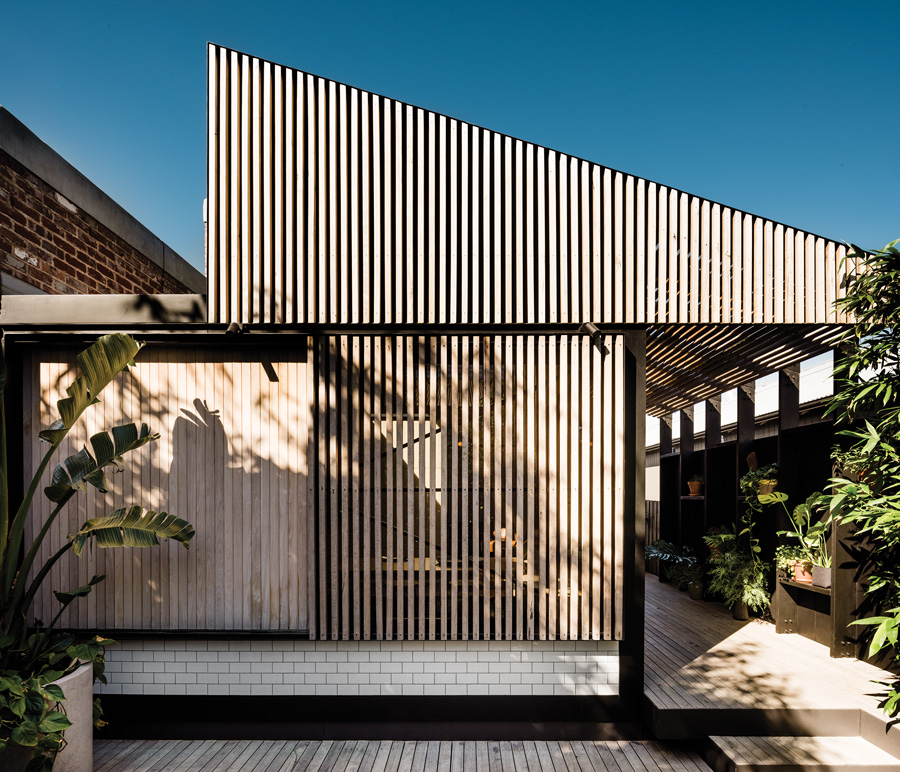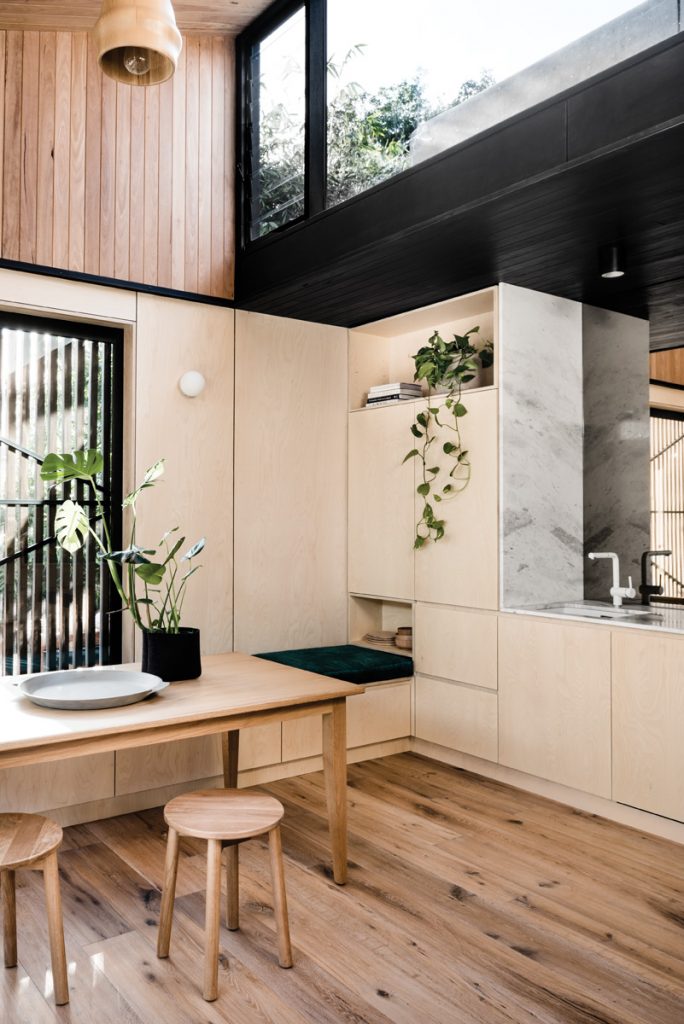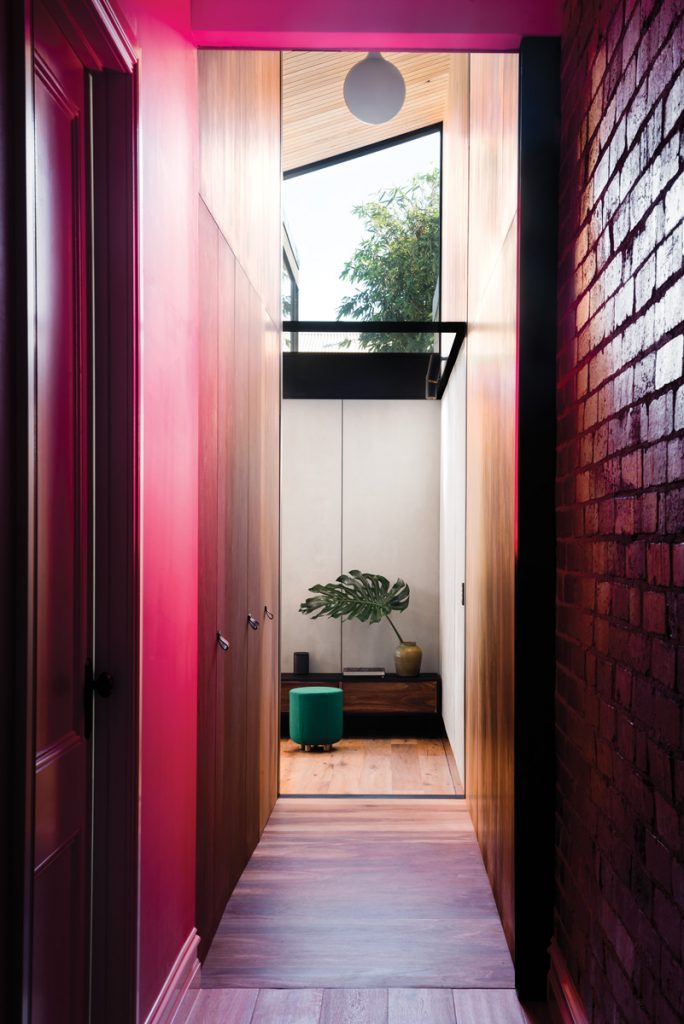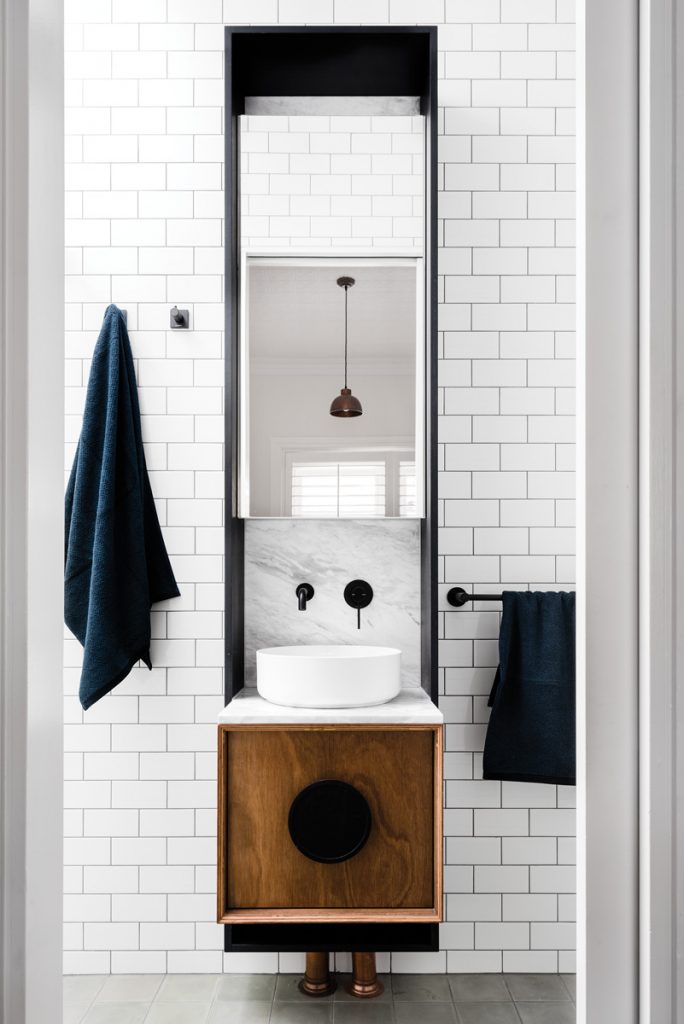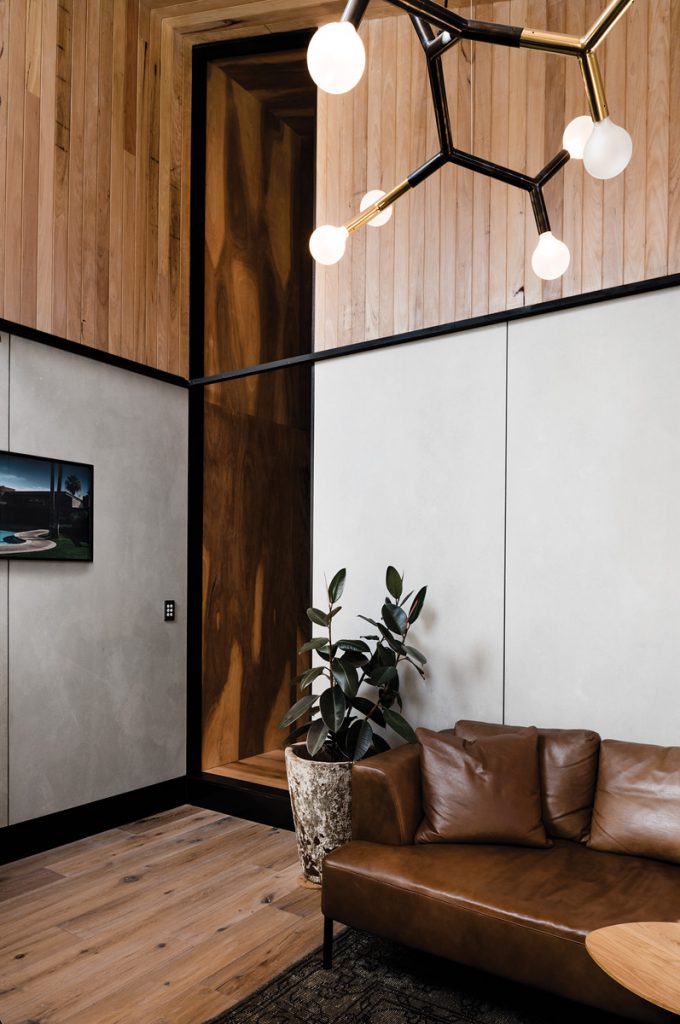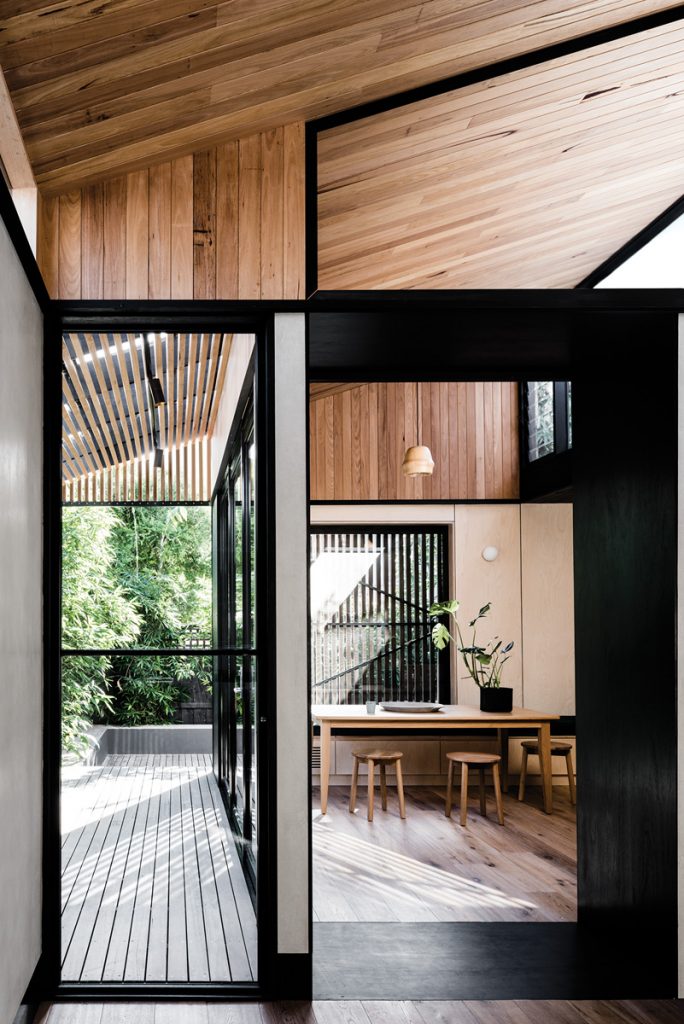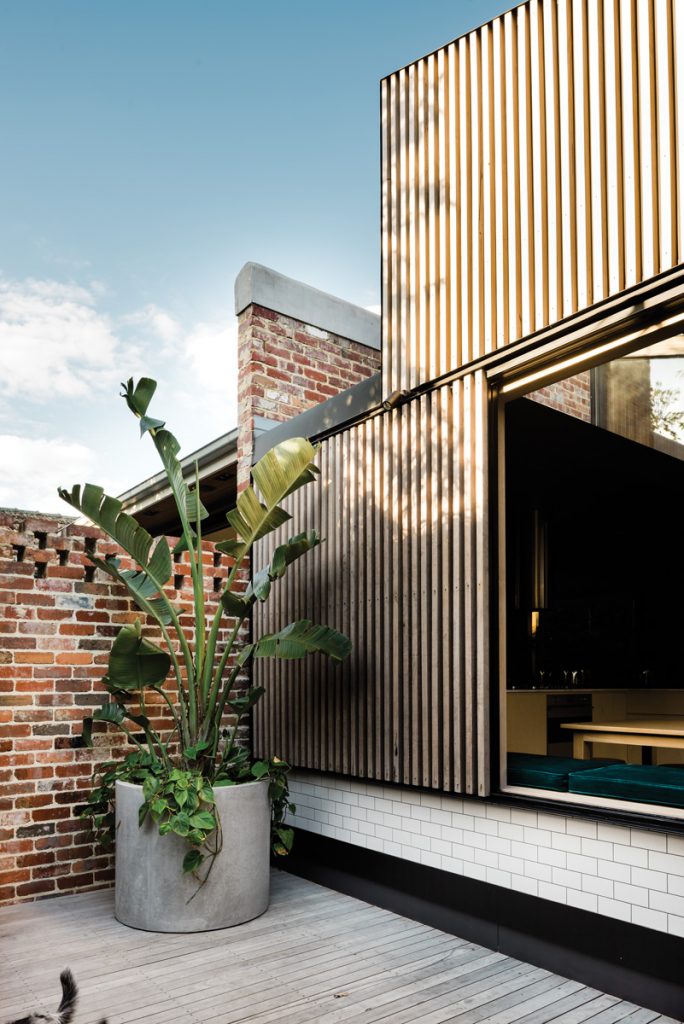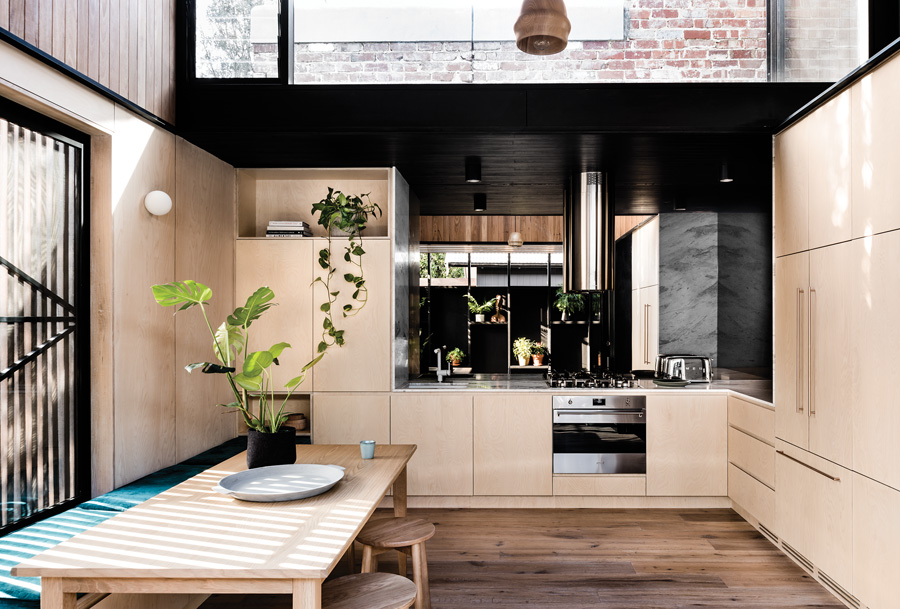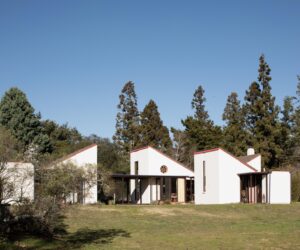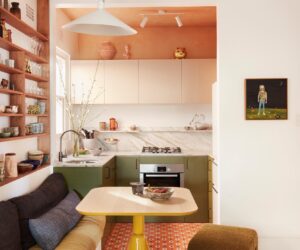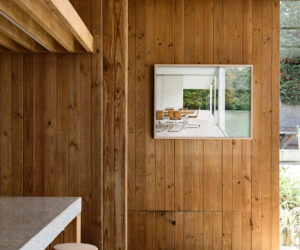Just a Little
Figr Architecture have re-created a family flexible home that’s small, comfortable and a little bit cheeky.
A house crumbling to pieces, freezing cold and with no natural light is not the best kick-off for family life. But for Michael Artemenko, Co-director of FIGR Architecture & Design, and his wife Emma, it was home.
Michael had bought the honest workers’ cottage in 2010, a classic semi-detached home in Cremorne, Melbourne’s sporting heartland. The a-ha moment came when the house began leaking one particularly hot summer, and the couple – Emma was also pregnant with their daughter Ruby – realised it was smarter to renovate and stay for the long term, rather than move on.
“That’s when we started to really question the value of every millimetre. What do you need to live, what is a luxury, and what can you do without?” Michael says.
The fundamentals included two bathrooms, three bedrooms, kitchen, dining room, a place to work that could convert to another bedroom, two living areas, a covered outdoor area, plus another outdoor area to play on. However, it was rather a lot for a footprint of just 187-square-metres. “I was also super conscious of all the materials, so nothing was wasted. The number of skips that people use is just incredible,” says Michael.
Acting for the first time as both client and architect, he quickly reined in the “crazy schemes” but held firm on the must-haves, using more with less and being clever with recycling, using leftover plywood for shelving, leftover copper for a laundry tap and feature door handle, cut-offs from the kitchen splashback also in the laundry and, crucially, avoiding the use of any structured steel, and less glass.
Beyond the entrance, the three front bedrooms have each been cleverly compressed into a smaller space. It’s allowed for a compact ensuite to adjoin the main bedroom. Original pressed metal ceilings have been brought back to life, while the long, exposed brick party wall has been retained as a nod to the area’s industrial past.
Here’s where things get interesting. Artemenko indulges his love for 1980s nostalgia with a strip of hot pink neon in the house’s “light corridor” – homage to Darth Vader’s light sabre from Star Wars. “We wanted to really celebrate that and play it up, so that’s where it all gets a bit of fun,” he laughs.
Jokes aside, the neon strip serves an important purpose as part of a larger transition space between the old and new house – or from the dark side to the new side. The light corridor also neatly conceals operational equipment, a laundry and storage.
The new wing flows from this bridge element, stepping down to a large living space with timber features and fibre cement walls (another ode to the home’s origins), with a nearby family bathroom, and kitchen and dining area just beyond.
The new spaces highlight different elements: the bathroom’s full-height penny round tiles bounce light playfully, while the main living area showcases European oak flooring to reference the old house’s Baltic pine floors.
But it’s the double-height highlight windows in the living area that are the true heroes of the house. They’re carefully positioned to maximise northern sun, and draw light deeply into the space as well as along the corridor, creating “a stream of amazing light”, as Artemenko explains.
The kitchen offers a different timber treatment again with blonde Russian birch plywood – appealing to Artemenko’s Eastern European heritage – and luxe highlights including a bronze mirrored splashback. There’s no island bench here, instead smart space-saving devices including a full-length banquette – or daybed – with under-bench storage, and a dining table that serves and seats.
“We’ve got more of a return feel like they had back in the day,” he says. To meet his brief’s two outdoor spaces, Artemenko took back space from the kitchen, and pushed out to the boundary with a covered side courtyard, featuring shelving cascading with greenery and direct access from the kitchen via bi-fold doors.
A seamless deck continues to the rear, containing a second leafy outdoor space, where a façade of vertical wooden slats slides across and opens the kitchen directly to the backyard. In doing so, the south-west orientation neatly avoids the western sun heat-box effect, instead creating a constant breezeway, and plenty of natural light to enjoy.
Now with a variety of nooks and crannies to relax in away from the ubiquitous open-plan design, Artemenko has created a family flexible home that’s equally comfortable whether someone is perched on the couch admiring the afternoon light at two o’clock – his favourite spot – or relaxed on the daybed with a tea or wine – Emma’s preferred space.
“We’ve been sustainable about life,” he says. “It’s not the biggest home but we’re really, really happy.”
It’s a journey that’s taken seven years, but Artemenko has gifted his family a home that tells a story that’s as much about themselves as it is about what came before.
“And we don’t have to move, ever,” he laughs. May the force be with you, indeed.
Specs
Architect
FIGR Architecture & Design
Builder
Grundella Construction
Passive energy design
The existing conditions determined that the proposed addition would be mostly oriented to the west and south with a five-metre-high party wall to the north. The design strategy for windows was that every part of the new building area is penetrated by natural sunlight throughout the winter and sheltered during summer. Windows and doors are positioned for effective cross-breezes. A covered south-facing verandah provides a cool shelter during the warmer summer months whilst the west-facing window to the kitchen has a large sliding sun screen with fly-screen built in. The design provides comfortable living with low-energy use year-round.
Materials
The main volumes are of highly insulated, lightweight, mainly timberframed construction, without any steel work. The existing structure of the house was salvaged and reused where possible. Living Datum walls: raw fibre cement wall paneling. Ceilings and walls: Shiplap silver top ash lining boards with Osmo wood wax finish. Kitchen Datum walls and joinery: Russian birch ply panels with Osmo raw wood wax finish. Ceilings and walls: Shiplap silver top ash lining boards with Osmo wood wax finish. Transition tunnel, bathroom and laundry joinery Spotted gum armor panel plywood with “Osmo” wood wax finish. All of the shelving, carcass, sides/door fronts and skirting boards were off-cuts from the remaining plywood. All leftover materials were recycled to fit out the roof space for storage. The architects reused as much material as possible to minimise building waste.
Materials
The main volumes are of highly insulated, lightweight, mainly timberframed construction, without any steel work. The existing structure of the house was salvaged and reused where possible.
Living
Datum walls: raw fibre cement wall paneling. Ceilings and walls: Shiplap silver top ash lining boards with Osmo wood wax finish.
Kitchen
Datum walls and joinery: Russian birch ply panels with Osmo raw wood wax finish. Ceilings and walls: Shiplap silver top ash lining boards with Osmo wood wax finish.
Transition tunnel, bathroom and laundry joinery
Spotted gum armor panel plywood with “Osmo” wood wax finish. All of the shelving, carcass, sides/door fronts and skirting boards were off-cuts from the remaining plywood. All leftover materials were recycled to fit out the roof space for storage. The architects reused as much material as possible to minimise building waste.
External finishes
Baltic pine timber weatherboards with compressed cement cladding, silver top ash shiplap timber and silver top ash 45 x 45 timber battens. Recycled bricks from demolition were used for external paving.
Flooring
French oak T&G flooring on yellow tongue sheet underlay. The building sits 800 mm above ground on stumps with timber structure.
Insulation
The roof is insulated with R6.0 Earthwool thermal insulation and Insulbubble reflective insulation sheet and sisalation. There’s bulk insulation to walls: 90 mm thick R2.5HD Earthwool and polastic thermal insulation sheet to external walls, plus 75 mm Earthwool sound control batts to all internal walls for improved sound insulation.
Glazing
Bi-fold windows are powder coated aluminum Lotus Glass Stax 75 with Low-E double-glazing. All other windows are KDHW timber framed (Cutek cd50 oiled) with Low-E double-glazing and Breezeway louvre inserts and awning/casement windows.
Heating and cooling
Glazing is oriented north-east for winter sun, and external shading is provided by retractable screen louvres for summer as well as a timber framed pergola. Effective cross-ventilation reduces the need for artificial cooling. A raised cathedral ceiling with a high-level Breezeway louvre window acts as a thermal chimney throughout summer, expelling hot air from inside and providing additional ventilation. In winter, due to strategic placement of glazing, caulk/gap sealing to all joints and the high level of insulation of the dwelling, the heating requirements are greatly reduced.
Lighting
The house uses low-energy LED lighting from Richmond Lighting and feature lights from Soktas, Chris Boots, Artemide and Ross Didier.
